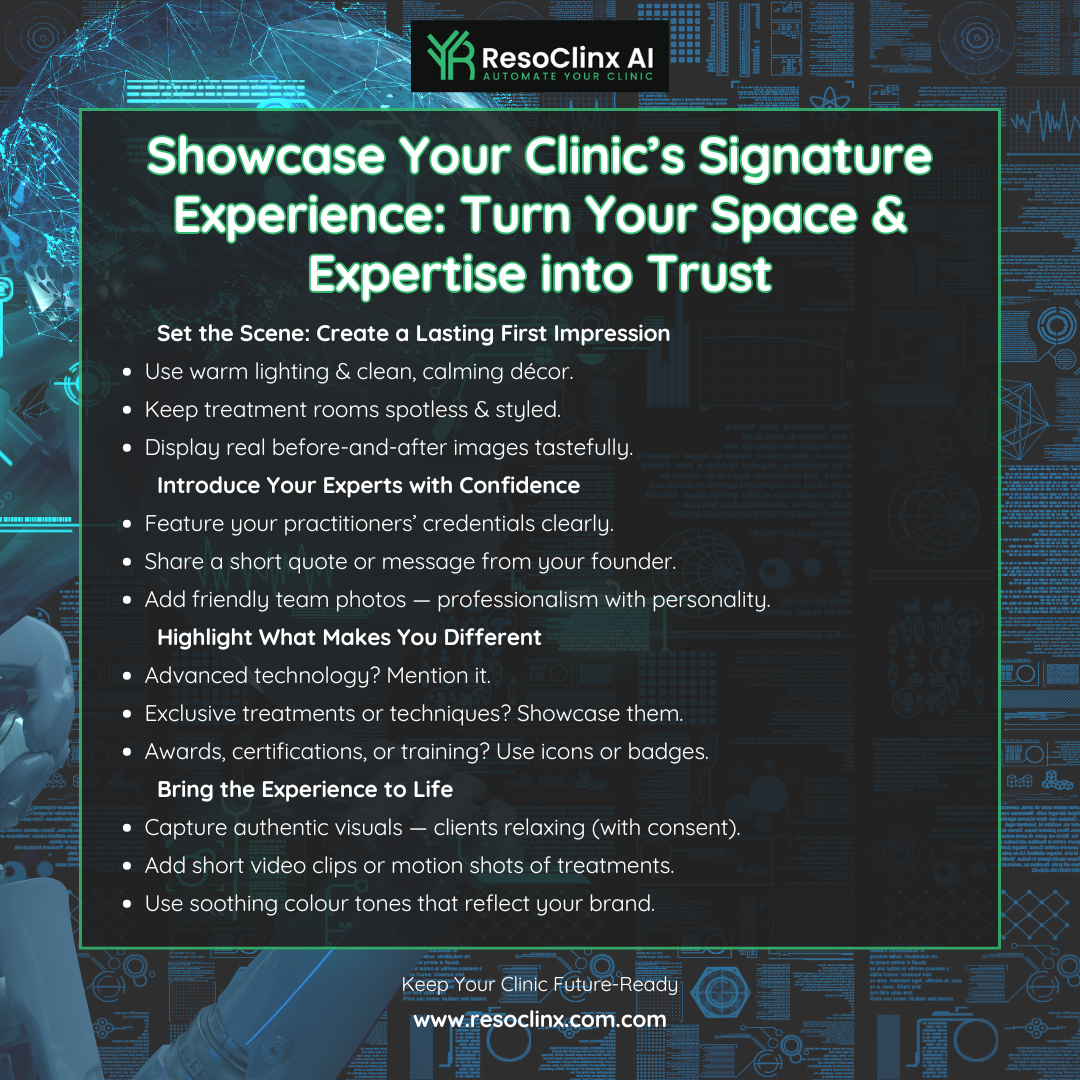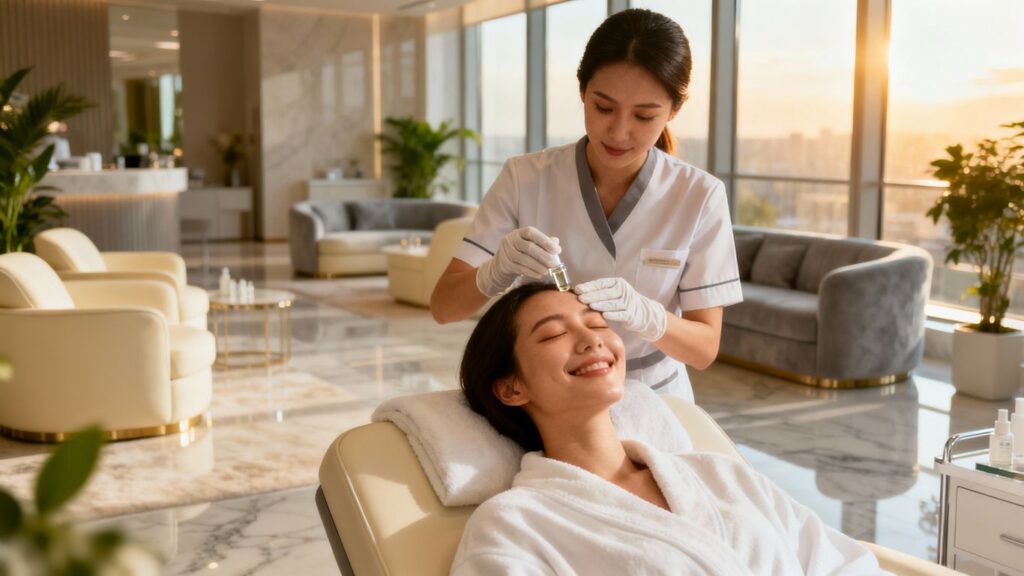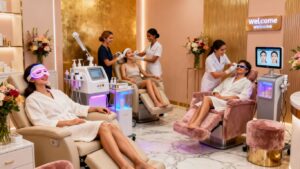Getting more people through the door at your medical spa or aesthetic clinic is always the goal. You want local clients to find you easily when they search online for treatments — and this guide will help you make that happen.
We’ll break down how to ensure your clinic appears when people nearby search for treatments like yours. It’s about making it effortless for them to discover you and book. Local SEO for medical spas and clinics is one of the most effective ways to grow your business sustainably.
Key Takeaways
- Make your Google Business Profile (GBP) shine — it’s your digital shop window. Add accurate details, professional photos, and regular updates to keep it active.
- Keep your Name, Address and Phone number (NAP) consistent across every online platform — from your website to local directories. This consistency helps Google verify and trust your business.
- Create dedicated service pages for each treatment you offer, explaining what it involves, who it’s for, and the results clients can expect.
- Encourage happy clients to leave Google reviews, and always respond — whether positive or negative — to show professionalism and care.
- Use local search phrases such as “Botox near me” or “facial treatments in [your town]” throughout your site to align with how people actually search.
Optimising Your Online Presence For Local Discovery

When people in your local area need a medical or aesthetic treatment, they usually start online. Ensuring your business appears in those searches is the first crucial step to attracting more clients.
Think of your online presence as your digital shop window – it needs to be clear, inviting, and easy for potential clients to find.
Establishing Your Digital Front Door: The Google Business Profile
Your Google Business Profile (GBP) is one of the most powerful local SEO tools for aesthetic clinics.
A complete and well-managed profile tells Google you’re a legitimate business and helps you appear in local map results. Claim your GBP listing and complete every field — including your business category, services, attributes (such as women-led clinic or wheelchair accessible), and website link.
This includes your exact name, address, and phone number (NAP), your opening hours (don’t forget any weekend or late evening times), the specific services you offer, and a link to your website.
Uploading good quality photos of your treatment rooms, reception area, and even your team can make a big difference too. It helps people get a feel for your spa before they even visit.
Ensuring Consistent Contact Details Across Directories
It’s really important that your business name, address, and phone number (your NAP details) are exactly the same everywhere online. Even small differences, like ‘Street’ versus ‘St.’ or a slightly different phone number format, can confuse search engines like Google.
This inconsistency can lower your ranking in local search results. Consistency builds credibility. Double-check that your NAP details match exactly across your website, Google Business Profile, and local directories like Yell, Treatwell, or the CQC register (if applicable).
Leveraging Local Citations For Enhanced Visibility
Local citations — mentions of your business name, address, and phone number — on trusted websites such as Yell, Yelp, and local Chamber of Commerce pages, strengthen your local authority. Ensure each one mirrors your GBP exactly to build trust with Google and potential clients.
Filling out these profiles completely, just like your Google Business Profile, will help boost your visibility in local searches. It’s all about making it easy for people in your area to find and trust you.
Crafting Compelling Content To Attract Clients
Your website content often forms a client’s first impression of your aesthetic clinic — make it as polished and reassuring as your in-person experience. It needs to do more than just list services; it should paint a picture of the experience you offer and speak directly to the needs and desires of your local audience.
Think of it as your digital waiting room – it should be welcoming, informative, and reflect the quality of care you provide.
Don’t just have a generic ‘Services’ page. Break down each treatment into its own dedicated space on your website. This allows you to go into detail about the benefits, what a client can expect during and after the procedure, and who it’s best suited for. For example, a page for ‘HydraFacial’ should explain the multi-step process, the types of skin concerns it addresses (like dullness or congestion), and the immediate glow clients can achieve.
Use keywords that people in your area might search for, such as ‘hydrating facial [Your Town]’ or ‘skin rejuvenation treatments near me’. Each page should include a strong call-to-action — for example, “Book your HydraFacial in [Town Name] today” — and use local search terms naturally throughout.
Showcasing Your Unique Ambiance And Expertise

People choose a medical spa not just for the treatments, but for the overall experience. Your website content should reflect this. Describe the atmosphere of your spa – is it a tranquil oasis, a modern and chic clinic, or something else?
Use descriptive language that appeals to the senses. Talk about your team’s qualifications and experience. Highlighting your practitioners’ credentials and specialisations builds trust and reassures potential clients that they are in capable hands. If you use specific high-quality product lines, mention them and explain why you’ve chosen them.
This level of detail shows you care about the client’s journey from start to finish.
Creating Engaging Visual Content For Your Website
This is a key part of effective aesthetic clinic marketing — clients aren’t just buying treatments; they’re choosing an experience and a trusted professional.
While this section focuses on written content, it’s impossible to ignore the power of visuals. High-quality photos and videos of your spa’s interior, your treatment rooms, and even your team (if they’re comfortable) can make a huge difference.
Avoid stock images where possible — authentic photos of your team and space build trust and strengthen your local SEO for clinics through image search optimisation.
For instance, an image of a relaxation lounge could have alt text like ‘Comfortable relaxation lounge at [Your Spa Name] medical spa in [Your Town]’. This helps search engines understand your content and can improve your visibility for local searches.
Enhancing User Experience For Seamless Bookings
A smooth, simple booking experience can make the difference between a website visitor and a confirmed client. Optimising your online booking process ensures potential clients can schedule their visit effortlessly.
Streamlining Your Appointment Booking Process
Think of your booking system as the first real interaction a client has with your spa after finding you online. It needs to be straightforward and user-friendly. A clunky or confusing process can lose you business before it even starts.
We want clients to feel relaxed from the moment they decide to book.
Here are a few ways to make booking a breeze:
- Clear Calls to Action: Make sure your ‘Book Now’ buttons are prominent on every page. They should be easy to spot and click.
- Online Booking System: Offer a system where clients can see available slots and book themselves in 24/7. Many people prefer this over making a phone call.
- Tap-to-Call Functionality: For those who prefer to speak to someone, ensure your phone number is clickable on mobile devices.
- Simple Forms: Keep booking forms short and to the point. Only ask for information you absolutely need.
A smooth booking experience not only helps clients but also frees up your staff’s time to focus on providing treatments.
Ensuring Mobile-Friendliness And Fast Loading Speeds
Lots of people search for spas on their phones, often when they’re out and about. Your website needs to look good and work well on any device, no matter the screen size. Slow loading times are a big turn-off. If your site takes too long to load, people will likely leave and find a competitor.
- Responsive Design: Your website should automatically adjust to fit any screen – phones, tablets, or desktops.
- Optimised Images: Large images can slow down your site. Make sure they’re compressed without losing too much quality.
- Fast Hosting: Choose a reliable web hosting provider that can handle your traffic.
- Minimal Code: Keep your website’s code clean and efficient to help it load faster.
Improving Website Navigation For Effortless Exploration
Once people are on your site, they need to be able to find what they’re looking for easily. A confusing website structure can frustrate visitors. Think about how someone new to your spa would explore your services.
- Logical Menu: Organise your services into clear categories (e.g., Facials, Massage, Packages).
- Search Functionality: If you have a lot of services, a search bar can be very helpful.
- Clear Service Pages: Each service should have its own page with details about what it involves, its benefits, and the price range. Link these directly to your booking system.
Building Trust Through Online Reputation Management

In today’s world, your online reputation is central to successful local SEO for medical spas. Reviews build trust before a client even steps through your door.
It’s like asking friends for recommendations, but on a much bigger scale. Making sure your online reputation is a positive one is a big part of getting more local bookings.
Encouraging and Responding to Client Reviews
Getting clients to leave reviews is the first step. Think about how you can make it easy for them. After a great treatment, a simple text message with a link to your Google Business Profile or a small card with a QR code can make a big difference.
Don’t be shy about asking – most happy clients are more than willing to share their positive experiences.
It’s not just about getting good reviews, though. You also need to respond to them. This shows you care about what your clients think, both the good and the not-so-good.
A polite and professional response to a negative review can actually turn a bad situation into a positive one, showing potential clients that you’re committed to customer satisfaction.
Here’s a simple way to approach review management:
- Ask for reviews: Make it a standard part of your post-treatment process.
- Respond promptly: Aim to reply within 24-48 hours.
- Be professional: Thank clients for positive feedback and address concerns constructively in negative reviews.
- Learn from feedback: Use reviews to identify areas for improvement.
Showcasing Positive Testimonials Effectively
Positive reviews are gold. Don’t just let them sit on Google or Yelp. Bring them to the forefront of your website and marketing materials. You can create a dedicated testimonials page on your website, featuring quotes from satisfied clients.
Short video testimonials can be incredibly powerful, too. Imagine a client talking about their amazing experience – that’s much more convincing than just text.
Consider highlighting specific services that clients rave about. If many people praise your signature facial or a particular laser treatment, make sure that’s visible. This helps potential clients see exactly what you excel at.
Addressing Feedback to Foster Client Loyalty
Every piece of feedback, whether it’s a glowing review or a constructive criticism, is an opportunity. When you respond thoughtfully to negative feedback, you’re not just managing a single complaint; you’re demonstrating your commitment to client care to everyone who reads it.
This can prevent future issues and build a stronger relationship with the client who left the feedback.
Building a strong online reputation isn’t just about attracting new clients; it’s also about keeping the ones you have. When clients see that you value their opinions and actively work to improve their experience, they’re more likely to return. This consistent positive interaction builds loyalty and turns satisfied clients into advocates for your spa.
Think of your online presence as a conversation. By actively participating, listening, and responding, you build a community around your brand that feels heard and valued. This is the bedrock of lasting client relationships and, ultimately, more bookings.
Strategic Local SEO For Increased Footfall

Getting people through your door is the ultimate goal, right? Local SEO is your secret weapon for making sure that when someone nearby searches for the services you offer, your medical spa pops up.
It’s all about being visible to the right people at the right time.
Targeting Location-Specific Keywords Effectively
Think about how people actually search. They don’t just type “facials”; they type “hydrafacial in [Your Town Name]” or “best Botox clinic near [Local Landmark]”. You need to get these specific phrases onto your website and your Google Business Profile.
This means looking at what terms people in your immediate area are using. Tools like Google Search Console can show you what people are already searching for that leads them to your site, even if you’re not ranking well for it yet. If you see a lot of searches for “laser hair removal near me” but your page isn’t optimised for it, that’s a clear sign to update your content.
Developing Neighbourhood And City Landing Pages
If your medical spa serves a wider area, or even just a few distinct neighbourhoods, it’s a good idea to create specific pages on your website for those locations. For example, you might have a page titled “Medical Spa Services in [Neighbourhood Name]” or “Your Local Clinic in [City Name]”.
On these pages, you can mention local points of interest or how easy it is to get to you from specific parts of town. This hyper-local approach helps Google understand exactly where you are and who you serve, making it easier for local residents to find you.
Collaborating With Local Businesses And Events
Think about who else serves your local community. Partnering with complementary businesses can be a smart move. Maybe a local boutique, a gym, or even a popular cafe could cross-promote with you.
You could offer a special discount to their customers, and they could do the same for yours. Sponsoring or participating in local events, like a town fair or a charity run, also puts your name out there. It shows you’re part of the community and can lead to direct bookings from people who meet you or hear about your services in person.
Measuring Success And Continuous Improvement
Tracking performance isn’t just about data — it’s about understanding what drives real bookings. Monitor your metrics, adjust your strategy, and focus on the areas bringing the most clients through your doors.
Updated note: You can now view Google Business Profile Insights directly in Google Search or Maps, where you manage your profile.
Tracking Key Performance Indicators For Local SEO
This is where we get down to the nitty-gritty. We need to keep an eye on specific things that tell us if our local SEO efforts are hitting the mark. It’s not just about how many people see your website, but what they do when they get there.
We’re looking for tangible results that lead to more appointments.
Here are some of the main things to watch:
- Local Search Rankings: Are you showing up when people search for services like ‘facials near me’ or ‘med spa [your city]’? We need to track your position for these important terms.
- Google Business Profile Insights: This is a goldmine of information. Look at how many people found you through Google Search or Maps, how many called you directly from your profile, and how many visited your website.
- Website Traffic: Where are your visitors coming from? Are they finding you through organic search (Google, Bing, etc.)? We want to see an increase in traffic from local searches.
- Conversion Rate: This is the big one. How many website visitors actually take the desired action, like filling out a contact form, calling, or booking an appointment online? We want this number to go up.
- Online Reviews: The number and quality of reviews you receive are a strong indicator of client satisfaction and can significantly impact local search visibility.
Analysing Website Traffic And Conversion Data
Once we’re tracking these numbers, we need to actually look at them and figure out what they mean. Google Analytics and Google Search Console are your best friends here. They give you a detailed picture of what’s happening on your website.
For example, you might see that a specific service page, like one for your popular anti-wrinkle treatments, is getting a lot of views but not many bookings. That’s a clue! Maybe the call to action isn’t clear enough, or perhaps the benefits aren’t highlighted as well as they could be. We can then look at:
- Top Performing Pages: Which pages are bringing in the most traffic and, more importantly, the most bookings?
- User Flow: How do people move around your website? Are they getting lost, or are they easily finding the information they need to book?
- Bounce Rate: If people are leaving your site immediately after landing on a page, something might be wrong with that page – maybe it’s slow to load, or the content isn’t what they expected.
- Source/Medium: Understanding which channels (organic search, social media, direct traffic) are driving the most valuable visitors helps you focus your efforts.
It’s easy to get lost in all the data, but the goal is simple: find out what’s working to bring in local clients and do more of that. Don’t be afraid to experiment and see what moves the needle.
Adapting Strategies Based On Performance Insights
This is the ‘continuous improvement’ part. The digital world changes, and so do your clients’ needs. What worked last month might not work as well next month. So, we need to be flexible and ready to adjust our approach.
If you notice that your rankings for a particular service are slipping, it might be time to update that service page with fresh content or look for more local citations. If your Google Business Profile isn’t getting as many calls as it used to, perhaps it’s time to add more photos or answer some new questions in the Q&A section.
Here are some ways to adapt:
- Refine Keyword Targeting: If you’re seeing traffic for keywords you didn’t expect, consider creating content around them.
- Update Service Pages: Keep information current, add new testimonials, or improve the booking process on pages that aren’t converting well.
- Boost Review Generation: If reviews are lagging, implement a more consistent strategy for asking satisfied clients for feedback.
- Test New Content Ideas: Based on what your audience is searching for, create blog posts or social media content that addresses their questions and needs.
By regularly reviewing your performance and making smart adjustments, you’ll keep your medical spa visible, attractive, and booked solid with local clients.
Bringing It All Together for More Bookings
Mastering local SEO for your medical spa or aesthetic clinic may feel overwhelming at first, but it’s ultimately about connection — making it easy for local clients to find and trust you. By keeping your Google Business Profile active, optimising your website, and nurturing positive reviews, you’ll build an online presence that consistently attracts and converts local clients.
It’s not about complicated tech; it’s about clear communication and being visible to potential clients right in your area. Stick with these steps, and you’ll start seeing more local appointments coming your way. It’s a practical way to grow your medical spa and connect with more clients who need your services.
Frequently Asked Questions
What is local SEO and why is it important for my aesthetic clinic or med spa?
Local SEO helps your aesthetic clinic or medical spa appear in local Google searches, such as “facials near me” or “Botox in [your town].” It’s essential because most clients discover new clinics online. If your business isn’t visible, you’re missing out on people actively searching for your services nearby.
How can I improve my Google Business Profile (GBP)?
Treat your Google Business Profile as your clinic’s digital shop window. Ensure your name, address, phone number, and opening hours are correct and match your website exactly. Upload high-quality, real photos of your clinic, team, and treatment rooms. Encourage happy clients to leave reviews — and always reply to show you value their feedback.
What type of content works best for an aesthetic clinic website?
Create dedicated pages for each treatment, such as Laser Hair Removal or Chemical Peels. Explain what the treatment involves, who it’s suitable for, and the results clients can expect. Use authentic photos and short videos to make your website more engaging and trustworthy.
Why are online reviews so important for my clinic?
Reviews are the digital version of word-of-mouth — they build trust before clients even contact you. A steady flow of positive Google reviews improves your local SEO rankings and helps potential clients feel confident in choosing your clinic. Always respond to feedback politely, including the occasional negative review, to show professionalism and care.
How can I make it easier for clients to book appointments online?
Make booking simple and seamless. Include a visible “Book Now” button on every page and ensure your phone number is clickable on mobile. If possible, integrate a real-time online booking system so clients can schedule appointments 24/7. A fast, mobile-friendly website also encourages more direct bookings.
What are local citations, and why are they important for SEO?
Local citations are online mentions of your clinic’s Name, Address, and Phone number (NAP) on trusted directories like Yell, Yelp, or the local Chamber of Commerce website. When your NAP details are consistent everywhere, Google recognises your clinic as credible and established — improving your local search visibility.






